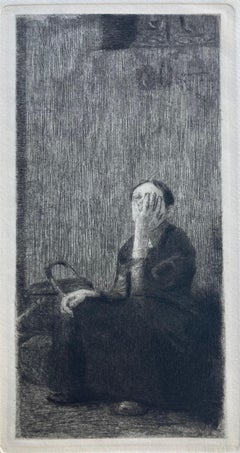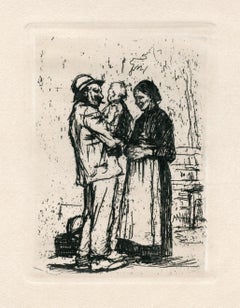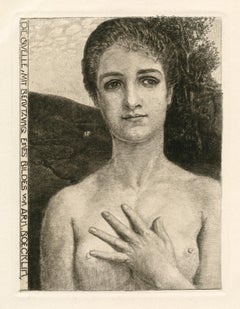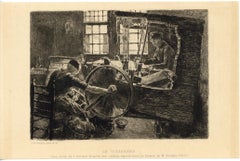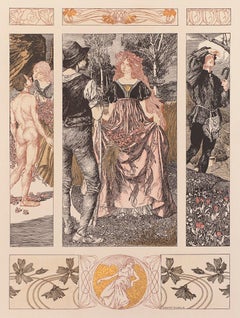19th Century Prints and Multiples
to
1
34
1
1
21
12
32
1
Overall Height
to
Overall Width
to
4,374
443
150
63
35
21
15
12
11
2
1
33
23
17
17
10
10
9
8
4
3
3
1
1
1
1
1
1
1
1
1
1
35
1,072
127
82
122
203
52
12
40
141
99
100
19
10
9
3
2
2
27
6
3
1
1
Style: Expressionist
Period: 19th Century
AM DER KIRCHENMAUER (At The Church Wall)
Located in Santa Monica, CA
KATHE KOLLWITZ (1867-1945)
AN DER KIRCHENMAUER (At The Church Wall), 1893 (45) (Klipstein 19 vi/vi: Knesebeck 19)
Etching and drypoint on wove paper. Unsigned; with the Alexander ...
Category
Expressionist 19th Century Prints and Multiples
Materials
Etching
"Begrüssung" original etching
Located in Henderson, NV
Medium: original etching. Catalogue reference: Klipstein 10. A very rich impression on cream wove paper of this Kollwitz etching, with plate tone. Plate size: 118 x 88mm (4 5/8 x 3 1...
Category
Expressionist 19th Century Prints and Multiples
Materials
Etching
"Die Quelle" original etching
By Max Klinger
Located in Henderson, NV
Medium: original etching and aquatint. Catalogue reference: Singer 325. Published in Vienna by Gesellschaft für Vervielfältigende Kunst in 1896. The plate measures 6 1/8 x 4 3/4 inch...
Category
Expressionist 19th Century Prints and Multiples
Materials
Etching
"Le Tisserand" original etching
Located in Henderson, NV
Medium: original etching. This impression on laid paper was published in Paris in 1898 by Gazette des Beaux Arts. Image size: 5 1/2 x 7 5/8 inches (142 x 195 mm). Not signed.
Condit...
Category
Expressionist 19th Century Prints and Multiples
Materials
Etching
Félix Vallotton ( Swiss 1865 - 1925) L’Exécution Woodcut 18/25 , Switzerland
Located in Meinisberg, CH
Félix Vallotton
(Swiss, 1865 - 1925)
L’Exécution
• Wood cut print
• Loose Japan paper sheet, 25 x 37 cm
• Block, ca. 15 x 25 cm
• Monogrammed in the ...
Category
Expressionist 19th Century Prints and Multiples
Materials
Paper, Ink, Woodcut
Spring by Robert Engels, Medieval Art Nouveau lithograph with gold ink, 1897
Located in Chicago, IL
Allegorien-Neue Folge was a serialized folio published in installments between 1895 and 1900. Martin Gerlach, its publisher, was inspired by the rise of modernist design in Vienna an...
Category
Vienna Secession 19th Century Prints and Multiples
Materials
Lithograph
Marc Chagall - Four Tales from the Arabian Nights - COMPLETE SET (12)
By Marc Chagall
Located in Los Angeles, CA
Marc Chagall (1887-1985)
FOUR TALES FROM THE ARABIAN NIGHTS (MOURLOT 36 - 47; CRAMER BOOKS 18)
The complete set of twelve lithographs printed in co...
Category
Expressionist 19th Century Prints and Multiples
Materials
Lithograph, Laid Paper
The Thirst, Plate 52 from Gerlach's Allegorien, Vienna Secession lithograph
Located in Chicago, IL
Wilhelm List, a friend and follower of Gustav Klimt, was a founder and leading member of the Vienna Secession and contributor to its official magazine, Ver Sacrum...
Category
Vienna Secession 19th Century Prints and Multiples
Materials
Lithograph
Astronomy, Plate 120 from Gerlach's Allegorien, Vienna Secession lithograph
By Hanus Schwaiger
Located in Chicago, IL
Allegorien-Neue Folge was a serialized publication of artworks by a group of Viennese artists and students beginning in 1897. Martin Gerlach, its publisher, was inspired by the new rise of modernist design in Vienna and selected those who were demonstrating a new command of the style to contribute works to the series, including Gustav Klimt, Koloman Moser, Carl Otto Czeschka, and Hanus Schwaiger. Each plate explores a different theme or collection of topics, such as dance, astronomy, electricity, and graphic arts, which brought a new aesthetic of design to the traditional allegory genre.
Stone lithograph of Hanus Schwaiger’s Astronomie, published as Plate 102 in Gerlach’s Allegorien...
Category
Vienna Secession 19th Century Prints and Multiples
Materials
Lithograph
Gerlach's Allegorien, plate #46: "Love" Lithograph, Gustav Klimt.
By Gustav Klimt
Located in Chicago, IL
Klimt’s association with Martin Gerlach dates back to the early 1880s when Gerlach and Schenk published their first edition of Allegorien und Embleme. By the mid-1890s, they were pla...
Category
Vienna Secession 19th Century Prints and Multiples
Materials
Lithograph
Gerlach's Allegorien Plate #37: "Music" Lithograph
Located in Chicago, IL
Koloman Moser
(1868 –1918), AUSTRIAN
Instead of applying his flair and art education solely to painting, Koloman Moser embodied the idea of Gesamt Kunstwerk (all-embracing art w...
Category
Vienna Secession 19th Century Prints and Multiples
Materials
Lithograph
Gerlach's Allegorien Plate #78: "Dance & Wine" Lithograph by Carl Otto Czeschka
Located in Chicago, IL
after Carl Otto Czeschka, (1878-1960), Austrian
A leading member of the Vienna Secession and later the Wiener Werkstätte (Viennese Workshop), Carl Otto Czeschka was a vital figu...
Category
Vienna Secession 19th Century Prints and Multiples
Materials
Lithograph
Gerlach's Allegorien Plate #75: "Hunting, Fishing, Rowing, Cycling"
Located in Chicago, IL
Koloman Moser
(1868 –1918), AUSTRIAN
Instead of applying his flair and art education solely to painting, Koloman Moser embodied the idea of Gesamt Kunstwerk (all-embracing art work) by designing architecture, furniture, jewelry, graphics, and tapestries meant to coordinate every detail of an environment. His work transcended the imitative decorative arts of earlier eras and helped to define Modernism for generations to come. Moser achieved a remarkable balance between intellectual structure (often geometric) and hedonistic luxury.
Collaborating with Gustav Klimt and Josef Hoffmann, the artist was an editor and active contributor to Ver Sacrum, (Sacred Spring), the journal of the Viennese Secession that was so prized for its aesthetics and high quality production that it was considered a work of art. The magazine featured drawings and designs in the Jugendstil style (Youth) along with literary contributions from distinguished writers from across Europe. It quickly disseminated both the spirit and the style of the Secession.
In 1903 Moser and Hoffmann founded and led the Wiener Werkstatte (Viennese Workshop) a collective of artisans that produced elegant decorative arts items, not as industrial prototypes but for the purpose of sale to the public. The plan, as idealistic then as now, was to elevate the lives of consumers by means of beautiful and useful interior surroundings.
Moser’s influence has endured throughout the century. His design sensibility is evident from the mid-century modern furniture of the 1950s and ‘60s to the psychedelic rock posters...
Category
Vienna Secession 19th Century Prints and Multiples
Materials
Lithograph
Gerlach's Allegorien Plate #20: "Song, Love, Music, Dance" Lithograph
Located in Chicago, IL
Koloman Moser
(1868 –1918), AUSTRIAN
Instead of applying his flair and art education solely to painting, Koloman Moser embodied the idea of Gesamt Kunstwerk (all-embracing art w...
Category
Vienna Secession 19th Century Prints and Multiples
Materials
Lithograph
Gerlach's Allegorien Plate #85: "Hunting" Lithograph by Carl Otto Czeschka
Located in Chicago, IL
after Carl Otto Czeschka, (1878-1960), Austrian
A leading member of the Vienna Secession and later the Wiener Werkstätte (Viennese Workshop), Carl Otto Czeschka was a vital figu...
Category
Vienna Secession 19th Century Prints and Multiples
Materials
Lithograph
Gerlach's Allegorien Plate #98: "Poetry" Lithograph by Carl Otto Czeschka
Located in Chicago, IL
after Carl Otto Czeschka, (1878-1960), Austrian
A leading member of the Vienna Secession and later the Wiener Werkstätte (Viennese Workshop), Carl Otto Czeschka was a vital figu...
Category
Vienna Secession 19th Century Prints and Multiples
Materials
Lithograph
Gerlach's Allegorien Plate #89: "Bookplate Spring" Lithograph
Located in Chicago, IL
Koloman Moser
(1868 –1918), AUSTRIAN
Instead of applying his flair and art education solely to painting, Koloman Moser embodied the idea of Gesamt Kunstwerk (all-embracing art work) by designing architecture, furniture, jewelry, graphics, and tapestries meant to coordinate every detail of an environment. His work transcended the imitative decorative arts of earlier eras and helped to define Modernism for generations to come. Moser achieved a remarkable balance between intellectual structure (often geometric) and hedonistic luxury.
Collaborating with Gustav Klimt and Josef Hoffmann, the artist was an editor and active contributor to Ver Sacrum, (Sacred Spring), the journal of the Viennese Secession that was so prized for its aesthetics and high quality production that it was considered a work of art. The magazine featured drawings and designs in the Jugendstil style (Youth) along with literary contributions from distinguished writers from across Europe. It quickly disseminated both the spirit and the style of the Secession.
In 1903 Moser and Hoffmann founded and led the Wiener Werkstatte (Viennese Workshop) a collective of artisans that produced elegant decorative arts items, not as industrial prototypes but for the purpose of sale to the public. The plan, as idealistic then as now, was to elevate the lives of consumers by means of beautiful and useful interior surroundings.
Moser’s influence has endured throughout the century. His design sensibility is evident from the mid-century modern furniture of the 1950s and ‘60s to the psychedelic rock posters...
Category
Vienna Secession 19th Century Prints and Multiples
Materials
Lithograph
Gerlach's Allegorien Plate #78: "Astronomy, The Creation, The Lie" Lithograph
Located in Chicago, IL
after Carl Otto Czeschka, (1878-1960), Austrian
A leading member of the Vienna Secession and later the Wiener Werkstätte (Viennese Workshop), Carl Otto Czeschka was a vital figu...
Category
Vienna Secession 19th Century Prints and Multiples
Materials
Lithograph
Gerlach's Allegorien Plate #93: "Science" Lithograph by Carl Otto Czeschka
Located in Chicago, IL
after Carl Otto Czeschka, (1878-1960), Austrian
A leading member of the Vienna Secession and later the Wiener Werkstätte (Viennese Workshop), Carl Otto Czeschka was a vital figu...
Category
Vienna Secession 19th Century Prints and Multiples
Materials
Lithograph
Gerlach's Allegorien Plate #114: "Vignettes" Lithograph by Carl Otto Czeschka
Located in Chicago, IL
after Carl Otto Czeschka, (1878-1960), Austrian
A leading member of the Vienna Secession and later the Wiener Werkstätte (Viennese Workshop), Carl Otto Czeschka was a vital figu...
Category
Vienna Secession 19th Century Prints and Multiples
Materials
Lithograph
Gerlach's Allegorien Plate #78: "Hunting" Lithograph by Carl Otto Czeschka
Located in Chicago, IL
after Carl Otto Czeschka, (1878-1960), Austrian
A leading member of the Vienna Secession and later the Wiener Werkstätte (Viennese Workshop), Carl Otto Czeschka was a vital figu...
Category
Vienna Secession 19th Century Prints and Multiples
Materials
Lithograph
Gerlach's Allegorien Folio, plate #58: "Sculpture" Lithograph, Gustav Klimt.
By Gustav Klimt
Located in Chicago, IL
As an artist trained in the applied arts, Gustav Klimt valued all forms of art, including the graphic arts. This final design from 1896 for inclusion in Allegorien published by Gerlach & Schenk demonstrates respect for artistic precedent and for a wide range of media and technique. The publication was printed in an unknown number of copies. Klimt’s rendering in latin of the title, “SCVLPTVR.,” with three-dimensional effect on the wall, is a figurative allusion to this medium as well as a literal reference to Ancient Rome. By doing the same with his signature and date in roman numerals on the right hand side of the image, Klimt places himself, The Artist, firmly in this linear and legitimizing context of art history and as its modern standard-bearer. Playing on Classical mythology and the story of Pygmalion, in which a statue comes to life, Klimt presents his modern Venus holding an apple. Klimt’s Venus exhibits a curvilinear softness; there are no angles. Klimt deftly shows the possibilities in a graphic image to give life to dark, wavy hair and tenderness to swelling breasts and belly. To further emphasize the allegory of thriving modern art, he contrasts his Venus with the cold, hard ancient classical head whose eyes are vacuous and whose hair is but a stylized mass of curls. Klimt’s living Venus stands in front of the large bust and large classical pillar upon which is a sculpture of a Sphinx and a Greek Attic bust. As if a gallery to represent sculpture’s “best of” through the ages, the upper horizontal panel includes bust depictions in marble, cast metal and wood...
Category
Vienna Secession 19th Century Prints and Multiples
Materials
Lithograph
Gerlach's Allegorien Plate #47: "Morning in the Spring" Lithograph
Located in Chicago, IL
Koloman Moser
(1868 –1918), AUSTRIAN
Instead of applying his flair and art education solely to painting, Koloman Moser embodied the idea of Gesamt Kunstwerk (all-embracing art work) by designing architecture, furniture, jewelry, graphics, and tapestries meant to coordinate every detail of an environment. His work transcended the imitative decorative arts of earlier eras and helped to define Modernism for generations to come. Moser achieved a remarkable balance between intellectual structure (often geometric) and hedonistic luxury.
Collaborating with Gustav Klimt and Josef Hoffmann, the artist was an editor and active contributor to Ver Sacrum, (Sacred Spring), the journal of the Viennese Secession that was so prized for its aesthetics and high quality production that it was considered a work of art. The magazine featured drawings and designs in the Jugendstil style (Youth) along with literary contributions from distinguished writers from across Europe. It quickly disseminated both the spirit and the style of the Secession.
In 1903 Moser and Hoffmann founded and led the Wiener Werkstatte (Viennese Workshop) a collective of artisans that produced elegant decorative arts items, not as industrial prototypes but for the purpose of sale to the public. The plan, as idealistic then as now, was to elevate the lives of consumers by means of beautiful and useful interior surroundings.
Moser’s influence has endured throughout the century. His design sensibility is evident from the mid-century modern furniture of the 1950s and ‘60s to the psychedelic rock posters...
Category
Vienna Secession 19th Century Prints and Multiples
Materials
Paper
Gerlach's Allegorien Plate #116: "Force, Thirst, Love" Lithograph
Located in Chicago, IL
after Carl Otto Czeschka, (1878-1960), Austrian
A leading member of the Vienna Secession and later the Wiener Werkstätte (Viennese Workshop), Carl Otto Czeschka was a vital figu...
Category
Vienna Secession 19th Century Prints and Multiples
Materials
Lithograph
Gerlach's Allegorien Plate #83: "Seasons" Lithograph by Carl Otto Czeschka
Located in Chicago, IL
after Carl Otto Czeschka, (1878-1960), Austrian
A leading member of the Vienna Secession and later the Wiener Werkstätte (Viennese Workshop), Carl Otto Czeschka was a vital f...
Category
Vienna Secession 19th Century Prints and Multiples
Materials
Lithograph
Gerlach's Allegorien Folio, plate #53: "Junius" Lithograph, Gustav Klimt.
By Gustav Klimt
Located in Chicago, IL
Contributors to Gerlach & Schenk’s publications valued design and innovation in the graphic arts just as much as they examined allegories as subject matter for exploration. Here, Gus...
Category
Vienna Secession 19th Century Prints and Multiples
Materials
Lithograph
Gerlach's Allegorien Plate #94: "Heads" Lithograph
Located in Chicago, IL
Koloman Moser
(1868 –1918), AUSTRIAN
Instead of applying his flair and art education solely to painting, Koloman Moser embodied the idea of Gesamt Kunstwerk (all-embracing art work) by designing architecture, furniture, jewelry, graphics, and tapestries meant to coordinate every detail of an environment. His work transcended the imitative decorative arts of earlier eras and helped to define Modernism for generations to come. Moser achieved a remarkable balance between intellectual structure (often geometric) and hedonistic luxury.
Collaborating with Gustav Klimt and Josef Hoffmann, the artist was an editor and active contributor to Ver Sacrum, (Sacred Spring), the journal of the Viennese Secession that was so prized for its aesthetics and high quality production that it was considered a work of art. The magazine featured drawings and designs in the Jugendstil style (Youth) along with literary contributions from distinguished writers from across Europe. It quickly disseminated both the spirit and the style of the Secession.
In 1903 Moser and Hoffmann founded and led the Wiener Werkstatte (Viennese Workshop) a collective of artisans that produced elegant decorative arts items, not as industrial prototypes but for the purpose of sale to the public. The plan, as idealistic then as now, was to elevate the lives of consumers by means of beautiful and useful interior surroundings.
Moser’s influence has endured throughout the century. His design sensibility is evident from the mid-century modern furniture of the 1950s and ‘60s to the psychedelic rock posters...
Category
Vienna Secession 19th Century Prints and Multiples
Materials
Lithograph
Gerlach's Allegorien Plate #51: "Summer" Lithograph
Located in Chicago, IL
Koloman Moser
(1868 –1918), AUSTRIAN
Instead of applying his flair and art education solely to painting, Koloman Moser embodied the idea of Gesamt Kunstwerk (all-embracing art w...
Category
Vienna Secession 19th Century Prints and Multiples
Materials
Lithograph
Gerlach's Allegorien Plate #35: "Love & Wine" Lithograph
Located in Chicago, IL
Koloman Moser
(1868 –1918), AUSTRIAN
Instead of applying his flair and art education solely to painting, Koloman Moser embodied the idea of Gesamt Kunstwerk (all-embracing art work) by designing architecture, furniture, jewelry, graphics, and tapestries meant to coordinate every detail of an environment. His work transcended the imitative decorative arts of earlier eras and helped to define Modernism for generations to come. Moser achieved a remarkable balance between intellectual structure (often geometric) and hedonistic luxury.
Collaborating with Gustav Klimt and Josef Hoffmann, the artist was an editor and active contributor to Ver Sacrum, (Sacred Spring), the journal of the Viennese Secession that was so prized for its aesthetics and high quality production that it was considered a work of art. The magazine featured drawings and designs in the Jugendstil style (Youth) along with literary contributions from distinguished writers from across Europe. It quickly disseminated both the spirit and the style of the Secession.
In 1903 Moser and Hoffmann founded and led the Wiener Werkstatte (Viennese Workshop) a collective of artisans that produced elegant decorative arts items, not as industrial prototypes but for the purpose of sale to the public. The plan, as idealistic then as now, was to elevate the lives of consumers by means of beautiful and useful interior surroundings.
Moser’s influence has endured throughout the century. His design sensibility is evident from the mid-century modern furniture of the 1950s and ‘60s to the psychedelic rock posters...
Category
Vienna Secession 19th Century Prints and Multiples
Materials
Lithograph
Gerlach's Allegorien Plate #44: "Music" Lithograph
Located in Chicago, IL
Koloman Moser
(1868 –1918), AUSTRIAN
Instead of applying his flair and art education solely to painting, Koloman Moser embodied the idea of Gesamt Kunstwerk (all-embracing art work) by designing architecture, furniture, jewelry, graphics, and tapestries meant to coordinate every detail of an environment. His work transcended the imitative decorative arts of earlier eras and helped to define Modernism for generations to come. Moser achieved a remarkable balance between intellectual structure (often geometric) and hedonistic luxury.
Collaborating with Gustav Klimt and Josef Hoffmann, the artist was an editor and active contributor to Ver Sacrum, (Sacred Spring), the journal of the Viennese Secession that was so prized for its aesthetics and high quality production that it was considered a work of art. The magazine featured drawings and designs in the Jugendstil style (Youth) along with literary contributions from distinguished writers from across Europe. It quickly disseminated both the spirit and the style of the Secession.
In 1903 Moser and Hoffmann founded and led the Wiener Werkstatte (Viennese Workshop) a collective of artisans that produced elegant decorative arts items, not as industrial prototypes but for the purpose of sale to the public. The plan, as idealistic then as now, was to elevate the lives of consumers by means of beautiful and useful interior surroundings.
Moser’s influence has endured throughout the century. His design sensibility is evident from the mid-century modern furniture of the 1950s and ‘60s to the psychedelic rock posters...
Category
Vienna Secession 19th Century Prints and Multiples
Materials
Lithograph
Kristiania Bohemians I
By Edvard Munch
Located in New York, NY
Edvard Munch (1863-1944) Kristiania Boheme I (or Kristiania Bohemians I; Drinking Session/Drinking Bohemians), etching, drypoint and burnishing, 1895, signed in pencil lower right, a...
Category
Expressionist 19th Century Prints and Multiples
Materials
Drypoint, Etching
Gerlach's Allegorien Plate #30: "Love" Lithograph
Located in Chicago, IL
Koloman Moser
(1868 –1918), AUSTRIAN
Instead of applying his flair and art education solely to painting, Koloman Moser embodied the idea of Gesamt Kunstwerk (all-embracing art w...
Category
Vienna Secession 19th Century Prints and Multiples
Materials
Lithograph
Gerlach's Allegorien, plate #66: "Tragedy" Lithograph, Gustav Klimt.
By Gustav Klimt
Located in Chicago, IL
Gustav Klimt created this image for inclusion in Gerlach & Schenk’s Allegorien the year before he formed the Vienna Secession. While this design is similar to his other inclusions, L...
Category
Vienna Secession 19th Century Prints and Multiples
Materials
Lithograph
Market in Grodek
By Emil Orlik
Located in New York, NY
Emil Orlik (1870-1932), Market in Grodek, etching and aquatint, 1898, signed in pencil lower right, in very good condition, trimmed just outside of the platemark and so with a small ...
Category
Expressionist 19th Century Prints and Multiples
Materials
Etching, Aquatint
Marc Chagall "Couples de paysans"
By Marc Chagall
Located in Los Angeles, CA
MARC CHAGALL 1887 - 1985
"Couples de paysans"
Color lit...
Category
Expressionist 19th Century Prints and Multiples
Materials
Lithograph
Recently Viewed
View AllMore Ways To Browse
Black Wood African Sculpture
Pair Mid Century Artwork
Vintage Jazz
Tiffanys In London
Vintage Map Poster
Mediterranean Poster
French Train Posters
Crescent Moon Art
Vintage Posters Usa
Small Botanical Print
Large Vintage Sign Letters
Retro Flower Illustration
Large Colored Glass Sculpture
Baroque French Prints
Vintage Cycle Painting
Vintage Eye Poster
My Retro Poster
Watch Posters
